
About UsThe Numismatic Bibliomania Society is a non-profit organization promoting numismatic literature. For more information please see our web site at coinbooks.org SubscriptionsThose wishing to become new E-Sylum subscribers (or wishing to Unsubscribe) can go to the following web page link MembershipThere is a membership application available on the web site Membership Application To join, print the application and return it with your check to the address printed on the application. Membership is only $15 to addresses in the U.S., $20 for First Class mail, and $25 elsewhere. For those without web access, write to: David M. Sundman, Secretary/TreasurerNumismatic Bibliomania
Society AsylumFor Asylum mailing address changes and other membership questions, contact David at this email address: dsundman@LittletonCoin.com SubmissionsTo submit items for publication in The E-Sylum, just Reply to this message, or write to the Editor at this address: whomren@coinlibrary.com
BUY THE BOOK BEFORE THE COINYou won't regret it! |
- WAYNE'S WORDS: THE E-SYLUM MAY 13, 2012
- LAKE BOOKS 111TH MAIL-BID SALE CATALOG AVAILABLE
- KOLBE & FANNING HOLD 125TH SALE
- LINK FIXED: WORLD NOTGELD 1914-1947, 2ND EDITION
- JOHN COFFEE 1928 - 2012
- CENTENARIAN JIM CHARLTON ATTENDS ONTARIO CONVENTION
- QUIZ ANSWER: YOUNG NUMISMATISTS AT STACK'S
- PETE SMITH'S THREE DEGREES OF DAVE BOWERS
- MORE ON ELECTRONIC BOOKS
- ON HIGH CONDITION VS ACTUAL USAGE
- MORE ON ANA CONVENTION TALK VIDEOS
- DEWITT SMITH COLLECTION RESEARCH; 1792 COPPER DISME QUERY
- NOTES FROM E-SYLUM READERS: MAY 13, 2012
- VERMEULE AND JACOBS AND THE BANK OF JAPAN
- MORE ON HAYM SOLOMON
- MORE ON HANS SCHULMAN
- ABEL BUELL'S 1784 MAP OF THE UNITED STATES
- QUERY: ROBERT BASHLOW INFORMATION SOUGHT
- BILL DANA'S APOLLO 17 ROBBINS MEDAL TO BE SOLD
- WAYNE'S NUMISMATIC DIARY: MAY 13, 2012
- CANADA'S NEW $20 DOLLAR BILL LEAVES A LOT TO THE IMAGINATION
- GEORGE SELGIN'S HISTORY OF THE PENNY
- QUERY: FRANKLIN PARISIAN MASONIC LODGE MEDAL INFORMATION SOUGHT
- FEATURED WEB PAGE: WORLD COIN NEWS
WAYNE'S WORDS: THE E-SYLUM MAY 13, 2012

New subscribers this week include Christopher Bolton and Holly Ponsell. Welcome aboard! We have 1,554 email subscribers, plus 175 followers on Facebook.
This week we open with updates from Fred Lake, David Fanning and Scott Tappa. Other topics include young numismatists at Stack's, electronic books, Hans Schulman and Canada's new $10 banknote.
To learn more about DeWitt Smith's silver Getz half dollar, a theft at Gorny & Mosch in Munich, Cornelius Vermule, Norman Jacobs and the Bank of Japan, tooth money of the "Solomon Islands" and medals that flew to the moon,, read on.
Have a great week, everyone!
LAKE BOOKS 111TH MAIL-BID SALE CATALOG AVAILABLE
Lake Books announces that its 111th mail-bid sale of numismatic literature is now available for viewing on their web site at http://www.lakebooks.com/current.html. The 470-lot sale features selections from the libraries of Robert H. "Bob" Yuell and David E. Litrenta. Bob Yuell was a dedicated Early Coppers fan with particular emphasis on Half Cents and Dave Litrenta is a consummate collector specializing in gold coinage and tokens/medals. Many of these books and catalogs have been inscribed by such luminaries as Bowers, Breen, Fuld and a number of other authors.
The sale has a closing date of Tuesday, June 12, 2012 at 5:00 PM (EDT) and bids may be placed by email, telephone, fax or regular mail. Don't forget that the earliest bid received wins ties, so bid early !
Lake Books
6822 22nd Ave. N.
St. Petersburg, FL 33710
727-343-8055 Fax 727-345-3750
KOLBE & FANNING HOLD 125TH SALE
 Kolbe & Fanning have announced their 125th mail-bid sale of important numismatic literature, which will close on Thursday, June 7. The sale features selections from the libraries of F. Gordon Frost, David J. Davis and a major coin firm, and includes significant works in virtually all areas of numismatic study.
Kolbe & Fanning have announced their 125th mail-bid sale of important numismatic literature, which will close on Thursday, June 7. The sale features selections from the libraries of F. Gordon Frost, David J. Davis and a major coin firm, and includes significant works in virtually all areas of numismatic study.
A list of highlights would be lengthy, but some notable works offered include:
- Conring's Rare 1675 Work on Ancient Jewish Coins.
- A Bound Collection of Articles by George F. Hill, from the Library of the Author, and Hill's Own Copy of His 1927 Select Greek Coins.
- An Original Set of Rizzo on Sicily.
- The Outstanding 1702 Quarto Work by the Académie Royale des Médailles et des Inscriptions on the Medals of Louis XIV.
- A Fine, Original Set of Dalton & Hamer.
- Chaudoir's Aperçu sur les monnaies russes.
- Domanig's Die deutsche Medaille.
- Hill's Monumental Corpus of Italian Medals of the Renaissance.
- Hirsch's Classic 1760 Bibliography.
- Several Volumes of the Trésor de numismatique et de glyptique, Including Volumes on Medals of the French Revolution and Renaissance Medals.
- A Remarkable Sammelband Compiled by George Sim.
- An Original 1875 Crosby in a Nova Constellatio Binding.
- The Rare Second Edition of Loubat.
- One of Only Ten Copies Issued of the Deluxe Leather-Bound Edition of Logan & McCloskey on U.S. Half Dimes.
- An Original Maris on New Jersey.
- A Very Rare Deluxe Edition of Prime's Classic 1861 Work.
- Several Plated Chapman Sales, Including Wilson, Jewett, Brown, Groves and Beckwith.
- Abner Kreisberg's Full Leather Copy of the World's Greatest Collection of U.S. Silver.
- An Unlisted Pennypacker Sale of the Ira Reed Collection.
- The Very Rare 1846 Cavaliere Campana Sale, Priced & Named
- Significant Runs of the Canadian Antiquarian and Numismatic Journal.
Kolbe & Fanning are honored to be offering material in this sale from the libraries of Gordon Frost and David Davis, two long-time clients well-known to many of our colleagues here and abroad. Works from their libraries are identified as such throughout the catalogue, and we are sure their new owners will appreciate them in the same way that they were valued before.
The catalogue is available for downloading from the Kolbe & Fanning website at www.numislit.com. Those on our mailing list should receive their printed copies soon. We invite bidders to peruse the catalogue carefully and let us know of any questions they may have. The sale includes an excellent variety of works and we trust that it will generate a good deal of enthusiasm.
David Fanning may be contacted at (614) 414-0855 or at df@numislit.com.
LINK FIXED: WORLD NOTGELD 1914-1947, 2ND EDITION
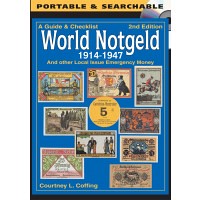 Scott Tappa of Krause Publications writes:
Scott Tappa of Krause Publications writes:
Our team has the notgeld product live in our store again.
For more information on the notgeld CD, see: www.shopnumismaster.com/cdd-gd-chklst-world-notgeld-1914-47
To read the earlier E-Sylum article, see: NEW BOOK: WORLD NOTGELD 1914-1947, 2ND EDITION (www.coinbooks.org/esylum_v15n18a06.html)
THE BOOK BAZARRE
JOHN COFFEE 1928 - 2012
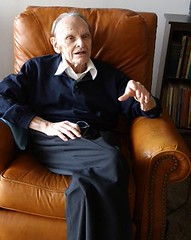 Tuesday evening David Schenkman mentioned to me the amazing longevity of John Coffee's run as editor of the journal of the American Vecturist Association.
Pete Smith writes:
Tuesday evening David Schenkman mentioned to me the amazing longevity of John Coffee's run as editor of the journal of the American Vecturist Association.
Pete Smith writes:
I learned that John Coffee died Tuesday evening. After producing "The Fare Box" for over fifty years, he was not able to do the last few issues and had some help from other AVA members.
To read an earlier E-Sylum article, see: FARE BOX EDITOR DR. JOHN COFFEE SIDELINED BY INJURY (www.coinbooks.org/esylum_v15n15a05.html)
CENTENARIAN JIM CHARLTON ATTENDS ONTARIO CONVENTION
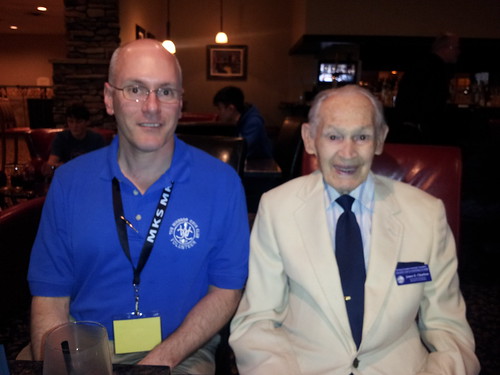
Bruce Perdue forwarded this note from Brett Irick:
Jim Charlton, an Ontario Numismatic Association founding member, attended the ONA convention last weekend. He is in great shape for a 100 year old. I am pictured on his left.
QUIZ ANSWER: YOUNG NUMISMATISTS AT STACK'S
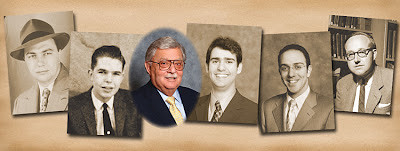
Harold Levi writes:
Left to Right: John J. Ford, Jr., Q. David Bowers, Harvey Stack, John Kraljevich., Vicken Yegparian, and Michael Druck (guess).
David Gladfelter writes:
John Ford, Q. David Bowers, [Harvey Stack,] John Kraljevich, Vicken Yegparian and Cornelius Vermeule.
Joe Boling concurs:
In the photos of YNs, I see Bowers, Kraljevich, and Yegparian on either side of Stack. I assume the two on the ends are Ford and Vermeule.
To read the earlier E-Sylum article, see: YOUNG NUMISMATISTS AT STACK'S (www.coinbooks.org/esylum_v15n19a22.html)
PETE SMITH'S THREE DEGREES OF DAVE BOWERS
Regarding the latest issue of our print journal, Bill Burd writes:
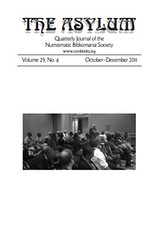 I received The Asylum last Friday. Pete Smith's article "Three Degrees of Dave Bowers" was great! For the readers of this article the degree of interest will be directly related to their involvement with the coin industry. Being in the business for 34 years I was able to relate to many of the personalities and companies and enjoyed the trip.
I received The Asylum last Friday. Pete Smith's article "Three Degrees of Dave Bowers" was great! For the readers of this article the degree of interest will be directly related to their involvement with the coin industry. Being in the business for 34 years I was able to relate to many of the personalities and companies and enjoyed the trip.
Perhaps once a decade appears an article of such outstanding importance that it should be studied by every major leader in his chosen field. Such an article is Three Degrees of Dave Bowers in the current issue just received. This article encapsulates the history, the management, the major players in the numismatic field -- and the business relationships of those major players -- in 23 pages.
This article could only have been written by Pete Smith. No other person in the numismatic field has the knowledge that is so evident in this essay, with the one possible exception of Dave Bowers himself. Pete has served his apprenticeship well for the present task by compiling the biographies of 1400 numismatic luminaries in his American Numismatic Biographies, first published in 1992 (in a rare limited edition of 25 copies). Two years ago he placed his entire biographical databank, updated and modified, on the web for all to access. See: www.coinbooks.org/resources/index.html .
For this article he piled fact on top of fact. For every two words there appears to be three facts. Forget literary transition and segway, this is a massive compendium of events in the lives of some of the most prominent people in numismatics, the movers and shakers. It's like Pete was adding one fact stone on top of another to build a tower of commercial numismatic structure..
As he perches on top of this summit he has the rare overview of the entire numismatic field and possesses the rare insight to perceive what is important. He has distilled a tremendous amount of shifting alliances to present the outcome of these actions for the reader to easily grasp. Thank you Pete for your magnificent work.
But what about the numismatic field? Here is my analysis based on Pete's report:
- The numismatic field is vibrant and well.
- Auction sales and auction companies dominate the field, as auctions prove -- historically and contemporally -- the most effective method of marketing numismatic material.
- David Bowers, unquestioned leader of the field, was correctly chosen as the center of commercial activity for, what, four decades? We are fortunate to have a person of his intellect and integrity to be so active in our field.
- Once a coin dealer has some success in buying and selling he graduates by increasingly larger "deals." It is inevitable this leads to multi-million dollar transactions, ultimately to buying and selling existing numismatic dealerships and auction firms. It is a normal progression of scale.
- Many of the commercial numismatic entities discussed in this article were short lived. Operated for a brief time and passed on to new blood.
- Only a handful of the numismatic firms in America have been in business for half a century or more. Few of those established by returning servicemen following World War II still exist.
- Firms in the field tend to be limited to the life of a single proprietor.
- Mom-and-pop coin shops are many; substantial large-scale numismatic firms are few.
- There are several two- and three-generation numismatic firms in America, but not many.
- We have no family dynasty numismatic firms in America like existed in England, notably Spinks and Seabys.
I literally read Pete's article three times. I learned some new insight with each reading. With all these shifting alliances, a reader needs a scorecard. Pete Smith furnished this.
MORE ON ELECTRONIC BOOKS
Regarding the CD of numismatic books Bruce W. Smith mentioned, Ken Bressett writes:
I was intrigued by Bruce Smith's article about the numismatic CD he found on eBay. But try as I may, I could not locate a place offering one for sale. Can you, or Bruce, give a source?
Bruce adds:
I have since found an eBay seller in England who has CD's for sale with hundreds of books on ancient coins and British coins. Also has long runs of Numismatic Chronicle (Royal Numismatic Society) the first 100 volumes (1836-about 1930) for around $15. Also has long runs of other European numismatic journals.
John Sallay writes:
Dave Bowers' excellent essay on THE USEFULNESS OF REAL (PRINTED) NUMISMATIC BOOKS mentions "the first the first truly numismatically useful reference book was published in America" - Felt's "An Historical Account of Massachusetts Currency", published in 1839. Copies of the original edition are indeed available for sale online priced in the $125-1,250 range, depending on condition. In my library, I have a reprint published by Burt Franklin in 1968, and one of these is also available online for $25. It's hard to avoid noting, however, that this book can be downloaded for free on Google Books. I don't believe that Felt's book is available for the Kindle yet, though.
I also wanted to pass along this attached cartoon from last week's New Yorker…
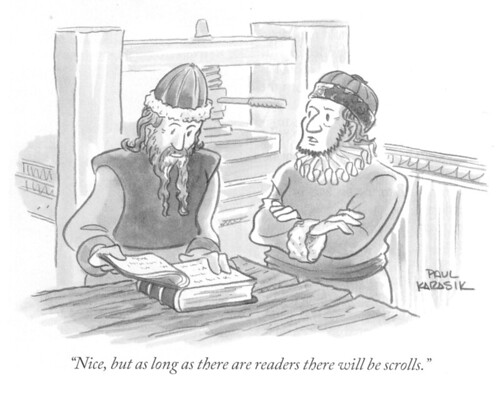
Scott Barman writes:
I went through a sample of the books listed on this CD. They are all available for free from Google Books (books.google.com). In fact, these are not the only books that can be found on the Google Books site. If you search for "coins" and "numismatics" you can find quite a few books available as a free download. I even found the book, "Domestic and Foreign Coins Manufactured by Mints of the United States" that covers mintages through 1980 on Google Books that I have on my iPad.
If I knew there was a market to repackage publicly available books, I would have done so myself! :-)
Scott adds:
Although the Red Book remains one of the most iconic numismatic reference, I stopped buying the book in the last few years since it is not available in ebook form. Why should I invest in buying a physical book that will take up space on a shelf when that book is practically out of date when it is printed and nearly useless next year when an update is printed? Sure, it will be a nice historical reference 20 years from now. But in an ebook format, it would only require a minute amount of storage space on a hard drive rather than waste what has become precious shelf space next to those must-have computer books I needed for my career that are now obsolete.
Whitman has been slow to the ebook party evidence by my inability to purchase the Red Book in e-book format. That cannot be said of their competition. Current editions of Krause's Standard Catalogues and U.S. Coin Digest now occupy a prominent position on my iPad. After buying these books on CD-ROM, I have copies on my computer, iPad, and iPhone as a ready reference. These electronic books have served me well and will get a good test run the next time I attend a coin show. After all, it is easier to carry an iPad around a big convention center than it is to cary bulky books.
Electronic books are the future of publishing and a key to providing the next generation of collectors, numismatists, and researchers with information in manner that suits their lives. More publishers should be embracing e-books as a way to reach new markets. If not, those publishers will not only be doing their business a disservice, but it will not help the numismatic community attract and retain the next generation to carry on the work the current generation has started. After all, colleges are now moving to electronic text books and e-readers. Do you really think that this generation that is growing up on e-books for solid information will step backward into paper?
Finally, thank you for the tip regarding Joseph Felt's "An Historical Account of Massachusetts Currency." I found a copy on Google Books and downloaded it as a PDF to be read on my iPad. The book can be found at books.google.com/books?id=87wrAQAAMAAJ and looks like an interesting read.
Bruce W. Smith writes:
The Internet is a great tool but it is only a tool. In the days of print, the only tool one needed was light. But the light itself was useless without the printed page to shine on. The same is true with the Internet -- it is a search tool to find information. But it can only find information that is there to find (and only if used correctly and patiently). Despite what people in their teens and twenties today believe, not everything is on the Internet.
I have around 15,000 books in my reference library. My 20-something daughter constantly asks me why I don't get rid of the books now that I have access to the Internet. I would guess that a large number of the 3,000 books I have on Chinese history and culture are not on the Internet. And I would guess that most of my books on Chinese numismatics are not online. Someday, perhaps they will, but don't expect it any time soon. And of course, searching for information in another language presents additional problems
To read the earlier E-Sylum article, see: A NUMISMATIC LIBRARY ON A CD (www.coinbooks.org/esylum_v15n19a07.html)
To read the earlier E-Sylum article, see: BOWERS ON THE USEFULNESS OF REAL (PRINTED) NUMISMATIC BOOKS (www.coinbooks.org/esylum_v15n19a08.html)
ON HIGH CONDITION VS ACTUAL USAGE
Last week Dave Hirt asked about the relative desirability of high condition numismatic items vs. those which are worn from actual use.

Harold Levi writes:
In one of the Stack's John J. Ford, Jr. auctions, there were two medallions made by Robert Lovett, Jr. for the Washington Light Infantry (WLI), of Charleston, South Carolina. The medals were presented to the 144 members of the WLI in November 1860.
One of the two medals had signs of having been worn by the recipient. The second medal was a high grade example that never had a suspension loop. I have strong reason to believe the second medal was Lovett's memento of the project.
The worn medallion sold for over $600. The unworn unused medallion sold for less than $300. One medal was worn by a Confederate soldier the other was not. Obviously, in this case, historical usage was more important than condition.
With another view, Alan V. Weinberg writes:
As to the "proof" condition of the Polk medal, I specified it descended down through President Millard Fillmore's family and was offered as such along with dozens of other Fillmore presidential ephemera so naturally it was in choice condition. Down through over a century, the choicer the Indian Peace medal, the higher the collector appeal and market value.
See the two John J. Ford, Jr. Stack's sales of Ford's IPM's for a comparison of values between a choice and abused or worn silver IPM. Unless a "beat up" silver IPM can be precisely documented to a specific famous and known Indian chief - and only a handful can - the condition of an IPM is very important to its appeal and value to any institution or collector.
Bruce W. Smith writes:
As stamp collectors know, a used stamp is often worth may times what an unused one is worth. To coin or paper money collectors, that is heresy. But there are three good reasons for this. First, many collectors simply prefer a used stamp -- something which actually went through the mail and has some connection to history. To them an unused stamp is an unblossomed flower. Second, in the late 1800's and early 1900's, stamp collecting was very popular, worldwide, but it was a new hobby with little literature. The result was that large numbers of forgeries -- even of common stamps -- were produced for sale to collectors.
One of the biggest counterfeiters, strangely, was the Scott Stamp Company, which used its forgeries to illustrate early editions of its catalogs! Those illustrations have long since been removed, and Scott repented fully. But for collectors, a postmark provides some measure of assurance that the stamp is genuine. Of course, forged postmarks were sometimes added to forged stamps, but this required extra work, and was usually reserved for forgeries of rare stamps.
Third, and perhaps most important, when a used stamp is worth more than an unused one, it is usually because the stamp is simply rare in used condition, but common in unused condition. This is particularly true for Chinese stamps of the 1940's. Due to the wartime and post war inflation, low denomination stamps simply could not be used for postage, but were often sold to stamp dealers for next to nothing. As the pace of inflation increased, new issues of stamps were in use for shorter and shorter periods, so that relatively few got used and even fewer survived and got into collections.
David Gladfelter writes:
Each of us must answer that question for him/herself.
I had two examples of a rare piece of New Jersey glass works scrip. One was an unsigned, never used remainder, nice and bright. It has been traded off to a fellow collector. The one you see here is the one that remains in my collection.
Another time Steve Tanenbaum and I divvied up a lot of Civil War era scrip. There were duplicate copies of Krause WI-370 SC2 and I gave Steve first pick. He chose the uncirculated remainder. I was happy with the issued note several grades lower. Guess you could put me in the Dave Hirt camp.
Granvyl Hulse writes:
It is a matter of show or tell. I am both a collector and a historian. As a farthing collector I hunt for the best condition I can find for show, but I am also a merit badge instructor for the Boy Scouts. I have an English shilling that was spit on for luck by a cab driver receiving his first payment of the day and a Mexican eight real covered with Chinese chop marks. These I take with me to tell the Scouts something about the interesting history of coins. Thus while I am always on the search for English farthings in top condition I am also on the lookout for coins, that in their usage, tell stories that will entertain.
To read the earlier E-Sylum article, see: QUERY: WHICH IS MORE DESIRABLE: HIGH CONDITION OR ACTUAL USAGE? (www.coinbooks.org/esylum_v15n19a12.html)
MORE ON ANA CONVENTION TALK VIDEOS
Dr. Ratnatunga had forgotten that he had signed a release for the videotaping and marketing of his lecture since it had taken place so long ago. I was never able to send him a copy because he had neglected to give me his mailing address. A copy is now on his way to him in Sri Lanka.
Regarding the ANA videos, all videos are available for free loan from the ANA Library to any ANA member. We list the videos for sale on Coinvideo.com along with all the other clubs and groups for whom we videotape. This includes; ANA, CSNS, EAC, FUN, PNG, TNA, and others. We have more than 1000 titles from taping for the last 25 years! Many of the older versions are still in the process of being digitized from their analog creation to be able to be made into DVD's.
We have thought about posting some of the titles for free on the Internet but this would not allow us to recoup our production costs. Ergo they are sold as DVD's to coin clubs and collectors. There are also several dealers who buy them for resale.
However we do have an arrangement with the website COINWeek.com in which I am a partner where some of the titles are available for free on a limited basis. The business model for all this is constantly evolving and keeping up with the technology is enough to make one's head spin!
To read the earlier E-Sylum article, see: NOTES FROM E-SYLUM READERS: MAY 6, 2012: On ANA Convention Talk Videos (www.coinbooks.org/esylum_v15n19a21.html)
DEWITT SMITH COLLECTION RESEARCH; 1792 COPPER DISME QUERY
Wayne Burt writes:
In the Brand material at the American Numismatic Society I found that DeWitt Smith owned a silver Getz half dollar. It was recorded under journal # 46846 with no grade. However, I located it in a paper called Rarities Box 2 page 2 where it was described as Unc Proof like with a scratch behind the head. This description matches the Robert Davis coin and fills the gap between Davis and F C C Boyd who acquired the coin in the 1940's. Ford acquired it from Boyd.
DeWitt Smith also owned the gold Washington coin from the Parmelee sale. It was recorded as journal # 46483 with a notation that it was Washington's pocket piece. This coin was sold to Wayte Raymond in 1933 who presumably sold it to Col. Green. Eric Newman acquired it from B G Johnson. This part of the pedigree was the subject of an question years ago and I am not sure if it was answered. I tried to relay the information to Eric Newman through a member of the ANS and got no reply.
I am currently working on a pedigree listing of the 1792 copper disme and would like to hear from anyone who has information on this.
To read the earlier E-Sylum article, see: WASHINGTON PATTERN COINAGE OF PETER GETZ SUPPLEMENT PUBLISHED (www.coinbooks.org/esylum_v15n19a03.html)
NOTES FROM E-SYLUM READERS: MAY 13, 2012
Zurich Money Museum iPad App
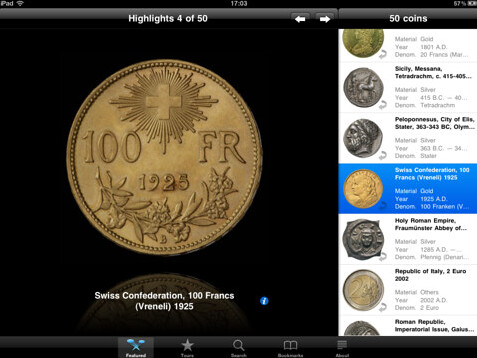
Scott Barman writes:
Regarding the Money Museum in Zurich, there is an app for that! CoinsHD is a an excellent app that shows off their collection very well. It is free for the iPad and can be downloaded from the iTunes App Store at http://itunes.apple.com/us/app/coinshd/id412443035 .
To read the earlier E-Sylum article, see: FEATURED WEB SITE: MONEYMUSEUM.COM (www.coinbooks.org/esylum_v15n19a30.html)
Catalogue of the Medals of Scotland
Regarding W.J. Elvin's question, D. J. Rampling writes:
A listing of Scottish Agricultural Medals can be found in R. W. Cochran-Patrick, 'Catalogue of the Medals of Scotland', published in 1884, pages 177-183. These pages can be accessed at www.archive.org/stream/catalogueofmedal00cochuoft#page/177/mode/1up.
Plate XXXIV in the book illustrates some of the medals. The author states in his Preface that the Catalogue "has no claim to be considered exhaustive", and this is certainly the case with regard to the Agricultural Medals.
To read the earlier E-Sylum article, see: QUERY: SCOTTISH AGRICULTURAL MEDAL INFORMATION SOUGHT (www.coinbooks.org/esylum_v15n18a20.html)
Theft at Gorny & Mosch, Munich
CoinsWeekly reports that
On Sunday, the 6th of May, unknown people broke into the Gorny & Mosch gallery in Munich and stole many coins. Be careful if you find any of them offered. We publish a comprehensive list.
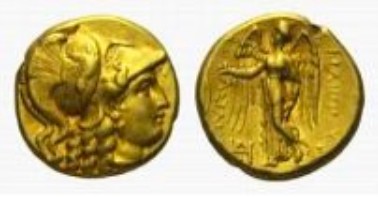 Macedonian Kings, Philipp III Arrhidaios, AV-stater.
Macedonian Kings, Philipp III Arrhidaios, AV-stater.
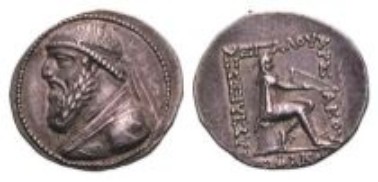 Parthians, Mithradates II, tetradrachm (15.98 g)
Parthians, Mithradates II, tetradrachm (15.98 g)
To view the complete list with images, see: Theft at Gorny & Mosch, Munich (www.coinsweekly.com/en/News/4?&id=1205)
More on Cotton Gloves
To read the earlier E-Sylum article, see:
MORE ON WEARING COTTON GLOVES
(www.coinbooks.org/esylum_v15n19a14.html)
A Folded Banknote Shirt
Among his many items on display was a clever use of multiple $1 bills folded to create a shirt to illustrate the theme, Don't Lose Your Shirt to Inflation." There was also a companion shirt of $2 bills with yellow buttons.
To read the earlier E-Sylum article, see:
EVERYDAY ART: THE BANKNOTE
(www.coinbooks.org/esylum_v15n18a28.html)
Labor rates in China
To read the earlier E-Sylum article, see:
PSYCHOTIC WOMAN TEARS UP BANKNOTES
(www.coinbooks.org/esylum_v15n19a29.html)
On the Usefulness of Counterfeit-Detecting Marking Pens
The use of the magic pens to validate currency will lead to many errors. It is not correct that "old" money will fail the test. I have tested notes back into the 1934 series, and they not only pass, but a few weeks after being marked, the marks have faded away. A note the fails has been contaminated with something during its circulating life that reacts to the pen. On the other hand, most teens can devise a way to make the products of their desktop printers pass the pen test.
To read the earlier E-Sylum article, see:
MAN ARRESTED FOR CARRYING A REAL $50 BILL
(www.coinbooks.org/esylum_v15n19a28.html)
American Numismatic Society Librarian Elizabeth Hahn writes:
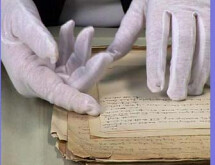 I was reading through the latest Es-Sylum and wanted to say that I enjoy the ongoing discussion and article links about wearing cotton gloves to handle rare books and manuscripts. We also get this question a lot here at the ANS Library and I have always preferred the practice of not wearing gloves but handling with clean hands for the very reasons outlined in the articles that were linked to in The E-Sylum (especially the brief overview by the preservation coordinator at the British Library). Now I have additional resources to point to when this question arises here again!
I was reading through the latest Es-Sylum and wanted to say that I enjoy the ongoing discussion and article links about wearing cotton gloves to handle rare books and manuscripts. We also get this question a lot here at the ANS Library and I have always preferred the practice of not wearing gloves but handling with clean hands for the very reasons outlined in the articles that were linked to in The E-Sylum (especially the brief overview by the preservation coordinator at the British Library). Now I have additional resources to point to when this question arises here again!
Howard Berlin writes:
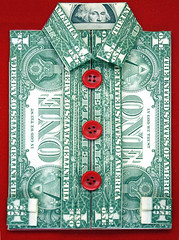 The April 29th E-Sylum issue mentioned the article of "Everyday Art: The Banknote" as an example of banknote folding "art." Several years ago I visited the Newman Money Museum on the campus of Washington University in St. Louis, where I did my graduate work in electrical and biomedical engineering years ago.
The April 29th E-Sylum issue mentioned the article of "Everyday Art: The Banknote" as an example of banknote folding "art." Several years ago I visited the Newman Money Museum on the campus of Washington University in St. Louis, where I did my graduate work in electrical and biomedical engineering years ago.
Ron Abler writes:
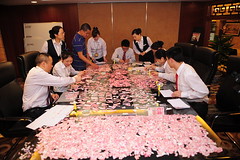 Labor rates must be even lower in China than I thought! The article claims that bank employees spent 72 man-hours reassembling a single 100 Yuan note (equivalent to less than $16!). That's 22 cents an hour!
Labor rates must be even lower in China than I thought! The article claims that bank employees spent 72 man-hours reassembling a single 100 Yuan note (equivalent to less than $16!). That's 22 cents an hour!
Joe Boling writes:
VERMEULE AND JACOBS AND THE BANK OF JAPAN
Last week Bruce Smith asked about how Cornelius Vermeule and Norman Jacobs were said to inventory the Bank of Japan coin collection. Jon Radel writes:
Is it possible that the rumors started with their acquisition of some of the Osaka Mint collection by trading in bullion before the collection was melted by the US Military Government? In any case, there are tantalizing bits of history both in Vermeule's 1953 introduction to Japanese Coinage, where the thanks given to Isao Gunji of the Bank of Japan and Secretary of the Oriental Numismatic Society don't hint of any strain, and in the biography of Norman Jacobs in the catalog of the Sept. 8, 2011 sale of the collection by Heritage. The latter gives some details of the Osaka Mint acquisitions and also states that "many of the most important items" were purchased from other collectors with the assistance of Isao Gunji.
Harvey Stack writes:
Both Cornelius Vermule and Norman Jacobs were in the U.S. Army during the Second World War and because of their knowledge of Japanese, Finance, Coin collecting and their wonderful education, were selected by the Finance Division of the Army to inventory the coin collection of the Bank of Japan.
It was customary to have our armed forces gather up the value in banks, museums and even educational institutions, to assess for our Government the assets of the conquered country.
They examined all, they inventoried it and left it where it be, usually in vaults till the calm after the war was complete. The usual procedure, by the United States was to get an idea of what was still in a conquered country, and then decide what goes to the United States and what remains. The attitude of our country was to leave the assets such as gold, silver, coins, currency and Art and the like, to help rebuild the infrastructure of the country and leave such historical values there to start their government with education and finance once again.
The same sort of inventories were made in Europe after the war, with similar results. If Mr. Smith wants to learn more of this type of procedure then ask him to look up the career of Leland Howard at the treasury department who was in charge of this procedure in Europe after World War II. He is the same Leland Howard who in 1960 managed at the Treasury Department the OFFICE OF GOLD AND SILVER OPERATIONS, which enforced during the 1960's the Import licensing of Gold Coins in to the U.S. and caused immense trouble with his regulations.
Joe Boling writes:
In addition to its own holdings, the Bank of Japan was the depository for crates of goodies that had been looted from occupied territories during WWII. Hundreds of wristwatches were among the booty, removed from POWs. I interviewed, in the 1970s, the former lieutenant who had been on orders as the custodian of the assets of the Bank of Japan. His last name was Young, and I don't now recall his given name (perhaps Arthur) - I probably could resurrect some notes of that interview if given enough time. I don't know if Jacobs and Vermeule were working for Young or not. One of Young's tasks was to try to identify the original owners (particularly POWs) of the artifacts, based on engraving or other identification markings.
When I visited Jacobs at his home in Carlisle, PA in the 1990s, he told me that the specimens of never-issued bank of Japan notes in his collection (one of which was also in my collection) had been made available to him while he was working in Tokyo in the 1940s, with the understanding that they would come back to the bank when his collection was broken up. That apparently did not happen. He transferred the collection to a son several years before his death, so technically it was not broken up on his watch.
To read the earlier E-Sylum article, see: YOUNG NUMISMATISTS AT STACK'S (www.coinbooks.org/esylum_v15n19a22.html)

MORE ON HAYM SOLOMON
Bruce W. Smith writes:
I saw the article about Haym Solomon and the Great Seal in The E-Sylum. As it happened, my mother sent me a copy of that email yesterday and asked me about it. A few days ago I found an old article in Numismatics International Bulletin, written by the late Ben Odesser, a well-known token collector in Chicago, and also a collector of Jewish memorabilia. His article pointed out that the Star of David was not a Jewish symbol. I have summed it up here:
I can also add that the so-called Star of David, also known as the Seal of Solomom, was not originally a Jewish symbol. The symbol first appears in ancient India long before the Jews were around. It was a magic symbol, and passed into other cultures as a magic symbol. In the 1700's, people in America were aware of the six pointed star as a magic symbol, and this is why it appears on American seals. All U.S. coins from the 1800's also have six pointed stars. Around the turn of the century (1900) the U.S. began to phase out 6 point stars in favor of 5 point stars. Why?
The 6 pointed star had been used on Islamic coins in the early 1800's (Morocco, for example) and probably before. Certainly not a Jewish symbol. But by the mid-1800's, a revival of Jewish mysticism had developed and the double-triangle star (Magen David) began to appear in Jewish publications. It was quickly identified with Judaism for reasons which aren't clear, and in the late 1800's, the Jewish Zionist Congress actually adopted it as its symbol. In the 20th century, it became THE Jewish symbol and now appears on the Israeli flag. But in the 1700's, this symbol was not associated with Jewish culture, and so Hayim Solomon could not have asked for it to be placed on the American Great Seal
Dan Freidus writes:
The Snopes article seems to deal with the Haym Solomon email point by point but if anyone wanted more info on Solomon, here are a few useful sources the references at his Wikipedia entry:
Christopher Young. 2011. Barnet Hodes's Quest to Remember Haym Salomon, the Almost-Forgotten Jewish Patriot of the American Revolution Barnet Hodes's Quest to Remember Haym Salomon, the Almost-Forgotten Jewish Patriot of the American Revolution (http://americanjewisharchives.org/journal/PDF/2011_63_02_00_young.pdf)
Info on the Chicago memorial to Washington, Solomon, & Robert Morris that Hodes commissioned:
Samuel Gruber's Jewish Art & Monuments
(samgrubersjewishartmonuments.blogspot.com/2009/07/
usa-haym-solomon-friends-monument-in.html)
Howard Fast. 1941. Haym Solomon: Son of Liberty.
To read the earlier E-Sylum article, see: WHO WAS HAYIM SOLOMON? (www.coinbooks.org/esylum_v15n19a19.html)
MORE ON HANS SCHULMAN
I only met Hans Schulman once, in the early 1970's. As far as I can recall, I only had one commercial contact with him. I ordered from his fixed price list what was described as a Chinese silver cash coin. When it arrived, it turned out to be a copper-nickel jewelry item, and not even correctly attributed. I was interested in the piece, but not at the price of an unlisted coin. No problem he replied -- send it back, I have other customers for it!
A few years later when I was working at Krause Publications, Russ Rulau mentioned that he owned stock in Schulman Coin and Mint and that they had an attractive stock certificate. The stock was issued at something like $7 a share originally, but Russ had bought his at 50 cents a share -- just before it went into bankruptcy. I said I would like to have one of those certificates, and he told me the stock was still being traded and put me in touch with his broker. The stock was then at 15 cents a share, so I bought 500 shares -- the smallest trade the broker would accept. I made it clear that I wanted one or more actual certificates, but I never got them.
A few months after making my investment, the company was liquidated. Before that happened, I was in New York and stopped at the Schulman shop. The fellow at the counter was polite, a bit cold, and didn't have anything to show me. When I mentioned that I was a stockholder, I was suddenly his best friend. "Come to the backroom" he said, "have something to eat or drink." On the way down the hall, I noticed a bushel basket full of teeth. When I asked about it, he said these were the famous Schulman tooth money. They appeared in his auctions from time to time as tooth money from the Solomon Islands or some other place, but they were really from New Jersey.
The fellow at the counter also related a story about Robert Bashlow. Most collectors know Bashlow as the guy who made the last restrike of the Confederate cent. I had heard of him because of a strange incident involving the 1962 aluminum coins of Irian Barat and the Riau Archipelago -- both in Indonesia. All the coins of both sets were worth around 25 cents each, but one edition of the Standard Catalog of World Coins had a typographical error, making them $25 coins! Bashlow flew to Indonesia, went to those islands and began buying up the coins. He ended up with barrels full of them, only to learn that the price was a mistake.
In the mid 1970's he consigned all those coins and a lot of other stuff to what was probably Schulman's last sale. The company went under and Bashlow never got paid.
To read the earlier E-Sylum article, see: MORE ON THE SCHULMAN MEDALLIC HISTORY OF MONEY AND BANKING (www.coinbooks.org/esylum_v15n19a13.html)
ABEL BUELL'S 1784 MAP OF THE UNITED STATES
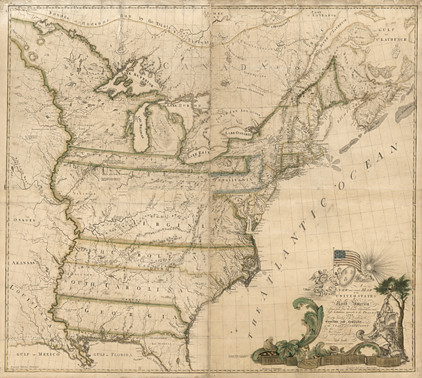
It's not numismatic and it's not a book but this may be of interest to a number of numismatists and bibliophiles due to Abel Buell's role as an engraver of dies for coppers during the 1780s.
The Connecticut Historical Society, which houses one of seven copies of his 1784 map of the United States, has recently gotten a grant for curating their map collection. This will include putting images of many online. See:
www.yourpublicmedia.org/content/connecticut-historical-society/
uncommonly-ingenious-mechanic
Until CHS posts good images, here's an auction lot description with high resolution (but slow-loading) images:
http://www.christies.com/LotFinder/lot_details.aspx?intObjectID=5382260
.
By the way, the NJHS copy sold in 2010 was bought by a private collector, David Rubenstein, who has lent it to the Library of Congress to exhibit it for five years. Given that it represents about 0.1% of his net worth, one can hope that he eventually donates it to LOC which would be a fitting home for it.
www.loc.gov/rr/geogmap/buellmap.html
www.loc.gov/loc/lcib/1103/maps.html
For those interested in maps, another private collector with a significant collection, though he doesn't own a Buell 1784 map (Rubenstein owns the only one known in private hands) has put his wonderful collection online: www.davidrumsey.com. In addition to displaying many wonderful maps, his site shows the use of some innovative image display software.
QUERY: ROBERT BASHLOW INFORMATION SOUGHT
Harold Levi writes:
In the form of one last call, does anyone have any letters or documents dealing with Robert Bashlow or the Bashlow Confederate cent restrikes? I have located several documents and letters dealing with these restrikes. These include a letter Bashlow wrote to Tom DeLorey in 1976, A.C. Frank Co. sales literature, and an unconfirmed 1962 Bashlow sales letter. There are other odds and ends of information I have gotten from David Laties.
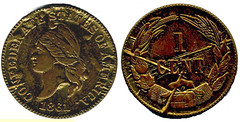 The manuscript is complete for the second edition of my book; The Lovett Cent; A Confederate Story. The bulk of the updates are for Robert Bashlow and his so-called Bashlow or 2nd Restrikes.
The manuscript is complete for the second edition of my book; The Lovett Cent; A Confederate Story. The bulk of the updates are for Robert Bashlow and his so-called Bashlow or 2nd Restrikes.
BILL DANA'S APOLLO 17 ROBBINS MEDAL TO BE SOLD
 One of only 80 Robbins medals that flew to the moon on Apollo 17 (estimate: $30,000+) from the collection of mission commander Gene Cernan and an American flag actually flown to the surface of the moon on Apollo 14 (estimate: $25,000+), from the collection of mission lunar module pilot Edgar Mitchell, are two of the top offerings in Heritage Auctions'' May 12 Space Exploration Event.
One of only 80 Robbins medals that flew to the moon on Apollo 17 (estimate: $30,000+) from the collection of mission commander Gene Cernan and an American flag actually flown to the surface of the moon on Apollo 14 (estimate: $25,000+), from the collection of mission lunar module pilot Edgar Mitchell, are two of the top offerings in Heritage Auctions'' May 12 Space Exploration Event.
"These are both very evocative pieces and represent what collectors love most about Space memorabilia," said Michael Riley, Chief Historian and Senior Cataloger at Heritage Auctions. "They've got legendary names, important missions and they not only witnessed those things but actually made it to the moon, or very close. In fact, there are more than 50 lots in this auction that flew to the moon."
An Apollo 14 lunar module flown gold medallion, presented to and from the Collection of Comedian Bill Dana (estimate: $15,000+) - famously known as José Jiménez, "the Chief Astronaut for the United States Interplanetary Expeditionary Force" - is already creating serious buzz within collector circles. The medallion was originally created by and gifted to Dana by Alan Shepard and his fellow astronauts in 1969 as a "10th anniversary" present of his "adoption" as the honorary eighth astronaut
To read the complete article, see: Apollo 17 flown Robbins Medal, Apollo 14 moon-landed American flag, lead Heritage Auctions sale (www.artdaily.org/index.asp?int_sec=2&int_new=55243)
To read a related earlier E-Sylum article, see: BILL DANA AND THE MERCURY ASTRONAUT SHORT SNORTER (www.coinbooks.org/esylum_v13n35a22.html)
WAYNE'S NUMISMATIC DIARY: MAY 13, 2012
Let's start this diary with an event from LAST Sunday - I picked up the phone and spoke to Eric Newman. Actually, at first I just listened to him and his wife Evelyn until I realized I had accidentally put my phone on mute. Eric wouldn't have heard me no matter how high he turned up his hearing aid.
Once I fixed that problem and called him back, we had a nice conversation. Eric is doing well and still working on numismatic projects as he approaches his 101st birthday on May 25th. We talked about his numismatic museum and Pete Smith's recent Asylum article on the history of coin firms associated with Q. David Bowers. He'd read it all in amazement of the rapid changes in the world of numismatic business in recent years.
Eric also reads every E-Sylum beginning to end, so all of you are in good company. He's impressed with the breadth of numismatic subject matter and credited me with knowing something about everything to edit it. Well, I didn't start out that that way, but being the editor has sure been a numismatic education. Eric's probably forgotten more than I'll ever really know. It was an honor and a pleasure to speak with him.
On Monday I made preparations for Tuesday's meeting of Nummis Nova, packing a briefcase with a couple binders of ephemera related to the U.S. Mint and the American Numismatic Society.
Tuesday's dinner was a delight. It was held at J. Gilbert's in Mclean, VA. The theme was counterfeits and fakes, and a number of very interesting items were passed around. I may write more about the meeting next week - it's getting late and I'm just running out of time for this issue.
On my drive home from work Wednesday I made a call (hand-free Bluetooth!) to Craig Whitford. Craig's a longtime E-Sylum subscriber. I wanted to reconnect with him about our common interest in the work of "money artist" J.S.G. Boggs. We'd both lost touch with him. We decided to work together to draft a listing of his works.
When I checked my email Wednesday evening, I learned that The E-Sylum had been added to Click Coins, a new web page by Michael Zielinski that's a handy one-stop-shop for links to several numismatic blogs, including the U.S. Mint, Coin World, Numismatic News, Coin Week, Scott Barman's Coin Collector's Blog and others.
Nothing more numismatic to speak of this week, but it was a fun one!
THE BOOK BAZARRE
CANADA'S NEW $20 DOLLAR BILL LEAVES A LOT TO THE IMAGINATION
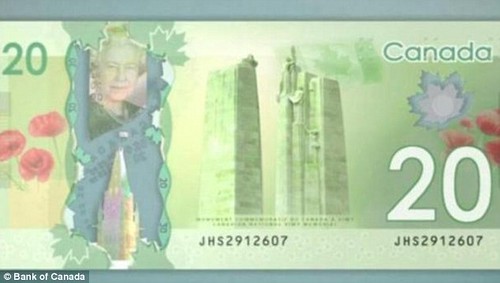
Canadians have been left confused over the country's new $20-dollar bill which some have said appeared to feature three naked woman and the World Trade Center towers.
The government was rolling out the new banknote as part of an upgrade of the monetary system. It actually features the Vimy Memorial in northern France, the largest monument overseas for Canadian soldiers lost the First World War.
However many Canadians believed the bill showed the Twin Towers and three topless women along with the head of state, Queen Elizabeth II.
The Vimy Memorial, a nationalist symbol of bravery and sacrifice, was seen on the $20 when it was unveiled by the Bank of Canada in Ottawa last week. Focus groups, typically made up of a wide-range of citizens from different generations, had examined the note before it was made public.
 In fact, the two columns of the Vimy Memorial symbolise the unity of France and Canada - represented by a maple leaf and fleur-de-lis.
In fact, the two columns of the Vimy Memorial symbolise the unity of France and Canada - represented by a maple leaf and fleur-de-lis.
The group of women at the top of the statue are known as the Chorus. The most senior figures represent Justice and Peace - the latter with a torch upraised.
The figures of Hope, Charity, Honour and Faith are located below Justice and Peace. Truth and Knowledge are positioned on the Western side.
The new $20 bill is due to come into circulation in November and has a high-tech polymer design. The note is currently the most counterfeited in circulation, accounting for more than half the bills in exchange.
To read the complete article, see:
'Three topless women and the Twin Towers': Canadians baffled by picture of WWI memorial on their new $20 dollar bill
(www.dailymail.co.uk/news/article-2141825/Canadas-new-20-dollar
-naked-women-Twin-Towers-it.html)
GEORGE SELGIN'S HISTORY OF THE PENNY
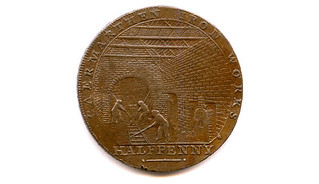 Our poor penny. Half a century ago, it was a respectable, if humble, piece of money. Just one could buy all sorts of candy or a postcard; three might buy a cherry cola or a newspaper.
Our poor penny. Half a century ago, it was a respectable, if humble, piece of money. Just one could buy all sorts of candy or a postcard; three might buy a cherry cola or a newspaper.
They were made of bronze -- copper with a touch of zinc and tin. Though not exactly precious, that metal was at least august enough for decorating brave soldiers and Olympic athletes.
But pennies have been on a downward slide ever since. By 1982, they were worth so little that people were melting them for their copper, causing the U.S. Mint to introduce today's version, made of cheap zinc disguised by a thin copper coat. Today even the zinc versions cost almost 2.5 times as much to make as they are worth -- costing taxpayers about $60 million last year. So Congress is considering another switch, to lowly steel.
Would it be better to simply give up on the penny, as Canada decided to do in March? The story of the British penny, first minted in the eighth century, offers an instructional case. It, too, came within an inch of dying. But it was saved by a handful of entrepreneurs.
The British penny started out as a silver coin. By the start of the 18th century, silver had become so valuable that pennies made from it were quickly melted down. So the Royal Mint quit making pennies except in tiny quantities used for ceremonial purposes. Halfpennies were made of copper, but they attracted enterprising counterfeiters. By 1775, the mint stopped coining copper altogether.
The hitch was that its decision came just as the Industrial Revolution was gaining steam. And that revolution called for unprecedented amounts of small change for paying workers' wages and stocking retailers' tills. Unless someone supplied the necessary coins, British economic development would come to a halt.
The Royal Mint stuck to its decision. Help came instead from some of the same entrepreneurs responsible for Great Britain's industrial liftoff. Leading the way were Thomas Williams, the owner of what was then the world's biggest copper mine, on the Welsh island of Anglesey, and Matthew Boulton, the owner of the world-famous Soho Manufactory, located just outside of Birmingham.
To read the complete article, see:
When Entrepreneurs Privatized the Penny
(www.bloomberg.com/news/2012-05-08/when-entrepreneurs-privatized
-the-penny.html)
QUERY: FRANKLIN PARISIAN MASONIC LODGE MEDAL INFORMATION SOUGHT
Howard A. Daniel III writes:
One of my wife's American heroes is Ben Franklin. She collects books, prints, medals, etc. with him on or in them. I was looking through a recently closed Baldwin's Auction in London and I saw a foreign medal with Franklin on it that I had never seen before. I know there are many collectors like my wife who might want to know about this medal.

United States of America. Benjamin Franklin (1706-1790), and the Parisian Masonic Lodge "Les Noef Soers", Copper Medalet, 1783, by Jean François Bernier, bust left, rev the nine Muses strive to build a temple, DE LEURS TRAVAUX - NAITRALEUR GLOIRE , plain edge, 30.5mm (Betts 618; Fuld FR.M.MA.2; Ford 14, 344 ($9000); BDM I, 175). Surface lightly rubbed, very fine and an exceptional rarity .
The Lodge, of the Grand Orient de France, was established in 1776 and became a considerable influence in the support of the American Revolution in France. Benjamin Franklin was Venerable Master in 1779, then was re-elected for the years 1780-1783. Other distinguished members included John Paul Jones, Voltaire, Jean-Antoine Houdon and, it is believed, Danton. In antiquity, the nine Muses, the daughters of Mnemosyne, were patrons of the arts and sciences. Ford had two specimens in silver and a single bronze specimen which "Mr Ford thought might be unique". £1200-1500
FEATURED WEB PAGE: WORLD COIN NEWS
This week's Featured Web Page is David Rivera's blog, World Coin News.Daily information about the releases of new world coin types and varieties. Will try to post information about official, legal tender coins only. I'm David Rivera, from Bilbao, Spain.

worldcoinnews.blogspot.com
